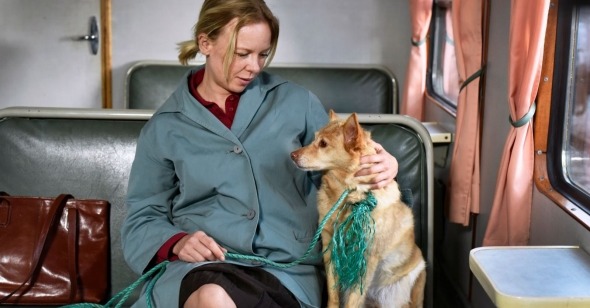A New Old World
By Dan Schindel
Fallen Leaves
Aki Kaurismäki, Finland, MUBI
The particular blend of formal rigor, narrative straightforwardness, and nimble playfulness in Aki Kaurismäki’s work means that he’s perhaps the sole director who evokes Chaplin, Bresson, and Jarmusch all in one film. But describing his new film, Fallen Leaves, as a “blend” or “child” of such inspirations would short change its particularities. The movie ends with a tribute to City Lights, as two people stroll into the distance. And then one of them notes that her dog’s name is Chaplin, turning the reference into an outright joke. (It also reminded me of the meta visual gag that capped The Fabelmans last year, a similarly warm parting gesture from a veteran filmmaker.) While hardly the sole practitioner of deadpan cinematic whimsy, Kaurismäki can push his methods close to magical realism; his little stories about ordinary people swing tremendous emotional heft.
Fallen Leaves is winkingly billed as the “lost fourth part” of Kaurismäki’s Proletariat Trilogy (1986’s Shadows in Paradise, 1988’s Ariel, and 1990’s The Match Factory Girl). Once again, he focuses on workaday protagonists: grocery stocker Ansa (her name is Finnish for “trapped,” and she’s played by Alma Pöysti) and construction worker Holappa (his first name is unrevealed, and he’s played by Jussi Vatanen). Both middle-aged, they shrug their way through their lives in a numb daze. She listens silently to radio dispatches from the Ukraine War, while he sneaks gulps from various stowed liquors while on the job. After meeting at a karaoke bar, their romance plays out mostly in silent gazes and simple exchanges. After a screening of Jarmusch’s The Dead Don’t Die, Ansa proclaims that she’s never laughed so much—no one is heard to laugh in this film, and they seldom smile.
Fallen Leaves accumulates simple but harrowing details to build its portrait of humdrum bullshit-job existence. Alma is fired from the supermarket for stealing expired food, and her next gig at a bar (obtained through a five-minute “interview”) does not last long before her boss is arrested for using it as a criminal front. When she has a dinner date planned with Holappa, she must buy a second plate and set of utensils. She’s living in an inherited studio apartment, getting the bad news about the outside world on a midcentury transistor radio. Absent its few contemporary touchstones like the war on the radio or that 2019 Jarmusch film, Fallen Leaves could easily have taken place at any point over the last several decades. Before Holappa’s alcoholism threatens to drive them apart, the pair’s biggest obstacle is a lost phone number that had been written on a slip of paper. Rather than a sense of timelessness, this seems to communicate time standing still or even being nonexistent. Maybe history truly did end, per Fukuyama. Even the film’s title speaks to a pervading purgatorial atmosphere.
And yet even when the night air is clearly freezing, Kaurismäki’s longtime cinematographer Timo Salminen captures so much warmth in the light and colors. There are rich, deep reds, creams, greens, and browns throughout the film. Shitty composite-wood tables and cheap lace cloths have never looked so oddly welcoming. All these details lend texture to Kaurismäki’s emphasis on how human connection can make all our burdens livable. When Ansa is fired, two of her co-workers quit in solidarity. A fellow boarder in Holappa’s residence lends him a jacket because he has none. Ansa’s little apartment is both figuratively and cinematically expanded when she takes in Chaplin from the street—once the dog is present, we see angles of the space besides the modest kitchenette and couch for the first time.
The happenstances and frictions that keep Ansa and Holappa apart—an early missed connection, the lost contact info, his stubborn refusal to quit drinking, an unexpected coma—recall a much more old-fashioned style of romantic melodrama, such as Brief Encounter. Amid a cinematic landscape in which the storytelling devices that separate lovers tend to be fully psychological, like identity-based anxieties or vague impostor syndrome, this style can feel like a lost art. This fusion of grit with the classical is what Kaurismäki’s been doing his whole career. As the world has changed around him, his old-fashioned sensibility has come around to feeling almost novel.
